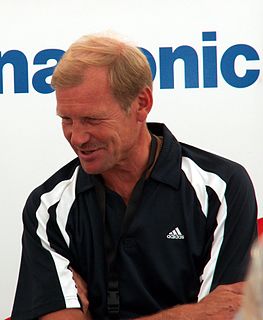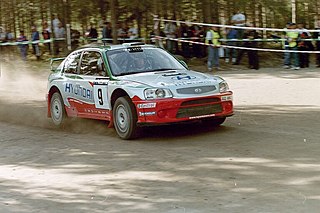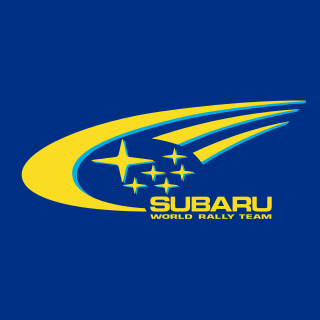
The World Rally Championship is the highest level of global competition in the motorsport discipline of rallying, owned and governed by the FIA. There are separate championships for drivers, co-drivers, manufacturers and teams. The series currently consists of 12 three to four-day rally events driven on surfaces ranging from gravel and tarmac to snow and ice. Each rally is usually split into 15–25 special stages which are run against the clock on up to 350 kilometres of closed roads.

"The Flying Finn" is a nickname given to several Finnish athletes who were noted for their speed. Originally, it was given to several Finnish middle and long-distance runners. The term was later extended to notable Finnish racing drivers.

Richard Alexander Burns was an English rally driver who won the 2001 World Rally Championship, having previously finished runner-up in the series in 1999 and 2000. He also helped Mitsubishi to the world manufacturers' title in 1998, and Peugeot in 2002. His co-driver in his whole career was Robert Reid. He is the only Englishman to have won the World Rally Championship as a driver.

Carlos Sainz Cenamor is a Spanish rally driver. He won the World Rally Championship drivers' title with Toyota in 1990 and 1992, and finished runner-up four times. Constructors' world champions to have benefited from Sainz are Subaru (1995), Toyota (1999) and Citroën. In the 2018 season he was one of the official drivers of the Team Peugeot Total. He received the Princess of Asturias Sports Award in 2020. Sainz is currently competing in Extreme E for the Acciona | Sainz XE Team alongside teammate Laia Sanz.

Juha Matti Pellervo Kankkunen is a Finnish former rally driver. His factory team career in the World Rally Championship lasted from 1983 to 2002. He won 23 world rallies and four drivers' world championship titles, which were both once records in the series. Both Sébastien Loeb and Sébastien Ogier have since collected more world titles, but no driver was able to repeat Kankkunen's feat of becoming a world champion with three different manufacturers until Ogier matched this achievement in 2020.

Rally Finland is a rally competition in the Finnish Lakeland in Central Finland. The rally is driven on wide and smooth gravel roads, featuring blind crests and big jumps. It is the fastest event in the World Rally Championship and has been dubbed the "Grand Prix of Rallying" and the "Grand Prix on Gravel". Rally Finland is among the largest annually organised public events in the Nordic countries, attracting hundreds of thousands of spectators each year. The rally has been known to be very difficult for non-Nordic drivers; only seven drivers from countries other than Finland or Sweden have won the event- in the 1980s and before, the field was made up almost entirely of Finnish and Swedish drivers.

Kenneth Eriksson is a now retired World Rally Championship rally driver. He drove for several manufacturer teams, including the Subaru World Rally Team, Mitsubishi, Hyundai and Škoda. He was the 1986 Group A Champion in the competition's only year, his best performance, overshadowed by the fatalities that occurred in that season.

Timo Salonen is a Finnish former rally driver who won the 1985 World Rally Championship season for Peugeot. It was commented of him that he stood out from other drivers, because he was overweight, wore thick glasses and smoked heavily, but still remained one of the fastest and most competitive drivers in the sport. He was also known for his relaxed attitude and for his habit of steering his rally car with one hand only. These factors led to the nickname Löysä ("Slack"). With his 7 rally wins he remained the most successful driver of Group B era (1983–1986) of WRC.
Ralliart is the high-performance and motorsports division of Mitsubishi Motors. It was responsible for development and preparation of the company's rally racing and off-road racing vehicles, as well as the development of high-performance models and parts available to the public. Ralliart scaled down its business activities in April 2010, though the brand will continue to be used by Mitsubishi.

Jimmy McRae is a British former rally driver. He was highly successful in the British Rally Championship, winning the title a record five times in 1981, 1982, 1984, 1987 and 1988 which as of 2020 still stands. In the European Rally Championship for drivers, he was runner-up in 1982, while his highest placing in the World Rally Championship was fifteenth in 1983. McRae runs a plumbing business in his home town of Lanark. He and his wife Margaret had three sons, Colin, Alister and Stuart. Both Colin and Alister McRae were World Rally Championship drivers. McRae's brother-in-law Hugh "Shug" Steele is also a former rally driver.
The 1984 World Rally Championship was the 12th season of the Fédération Internationale de l'Automobile (FIA) World Rally Championship (WRC). The season consisted of 12 rallies following the same schedule as the previous season. Stig Blomqvist beat the defending world champion and Audi teammate Hannu Mikkola to the drivers' title. Audi took their second manufacturers' title, ahead of Lancia and the debuting Peugeot.
The 1987 World Rally Championship was the 15th season of the Fédération Internationale de l'Automobile (FIA) World Rally Championship (WRC). The season consisted of 13 rallies in the same venues of the previous season. The only alteration to the schedule was the move of the Olympus Rally from December to June on the calendar.
The Asia-Pacific Rally Championship (APRC) is an international rally championship organized by the FIA encompassing rounds in Asia and Oceania. Group N cars dominated the championship for many years but in recent years cars built to R5 and S2000 regulations have tended to be the frontrunners.
The 1989 World Rally Championship was the 17th season of the Fédération Internationale de l'Automobile (FIA) World Rally Championship (WRC). The season consisted of 13 rallies, with some adjustments to the schedule versus the previous season. The WRC ended its participation in North America by removing the Olympus Rally from the schedule, implementing in its place Rally Australia. An anomaly in the schedule was that 1989 was the only year in which the Swedish Rally and the Rallye de Monte Carlo were switched in place, with the Swedish event taking place to start the year. This made it the second and last time that Monte Carlo would not mark the first event of the WRC season until the 2009 season.

The Ford World Rally Team, also known as the Ford Motor Co. Team prior to 2005, is Ford Motor Company's full factory World Rally Championship team. In its current form, it has been a competitor since the 1997 season, when Ford Motor Company's motorsport arm selected the Malcolm Wilson Motorsport company to run its factory team, entering the Ford Escort World Rally Car. The new team took their first victory in the 1997 Acropolis Rally.

The Subaru World Rally Team (SWRT) was Subaru's World Rally Championship (WRC) team. It used a distinctive blue with yellow colour scheme that is a throwback to the sponsorship deal with State Express 555, a BAT cigarette brand popular in Asia. 555 logos were found on Subaru cars from 1993 to 2003, although less prevalent since 1999 due to BAT's participation in Formula One with British American Racing. Subaru's WRC efforts date back to 1980, however, in 1989 British firm Prodrive took over its operations, and its base moved from Japan to Banbury, England.

The Ford Escort RS Cosworth is a rally version homologation special of the fifth generation European Ford Escort. It was designed to qualify as a Group A car for the World Rally Championship, in which it competed between 1993 and 1998. It was available as a road car from 1992 until 1996 in very limited numbers. The first 2500 cars made before 1 January 1993 are in fact "Homologation special versions." It was instantly recognisable due to its large "whale tail" rear spoiler. One of the main selling points was the Cosworth YBT, a highly tunable turbocharged 2.0 L (1,993 cc) with a bore x stroke of 90.8 mm × 77 mm Inline-four engine which had an output of 227 PS in standard trim. Tuning companies have achieved power outputs of over 1,000 bhp.
The 2000 Race of Champions took place on December 10 at Gran Canaria. It was the 13th running of the event, and the ninth running at Gran Canaria. The International Masters contest was held for the final time this year before a format shake-up for 2001, which opened up the main competition to non-rally drivers.
The following outline is provided as an overview of and topical guide to auto racing:











